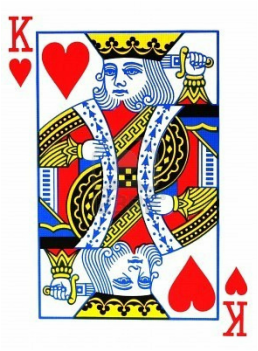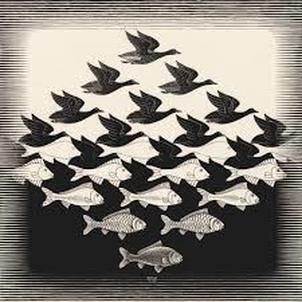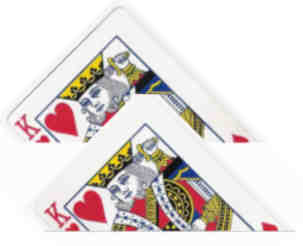 Here are two interesting questions I posed to my students in our unit on the transformation of shapes. (1) Playing card (on right): Where is the line of symmetry? I handed each pair of students a printout of the king of hearts and asked them to identify the line of symmetry. (2) M.C. Escher (below): Is this drawing symmetrical? Why or why not? It may be a good idea to preface both of these questions with, "What is symmetry? Give an example to support your answer?"
tedious, and it gives me some time to respond to all their entries. I try to vary the writing assignments as much as possible to add interest to the lessons, and students are encouraged to include pictures or diagrams to support their explanations.
The Solution: Both the above questions are meant to test how well students understand the idea of symmetry. Symmetry is any transformation that leaves the original shape or object unchanged. (1) In the playing card example, students often say that the line of symmetry is horizontal, vertical, or diagonal. In fact, there is no line of symmetry - as that would indicate reflective symmetry (mirroring an image). The type of symmetry exhibited on a playing card is rotational symmetry by 180 degrees (or point symmetry), meaning that you can cut the image in half at any angle through the centre of rotation, and the two halves will look exactly the same upside down. (I actually got my students to cut their playing cards in half at different angles to illustrate this property). (2) Most students are likely to state that the drawing does not exhibit any type of symmetry at all. Again, students at this stage tend to be familiar only with the idea of reflective symmetry. I will accept their answer as long as they provide a suitable justification. However, what I'm trying to get across with this question is that tessellations (translating an image/object) are a type of symmetry also. This creates a nice lead in to further discussion on geometry as it relates to art, or vice versa.
0 Comments
Leave a Reply. |
April SooInternational math educator who writes, occasionally. Archives
April 2020
Categories
All
|



 RSS Feed
RSS Feed
